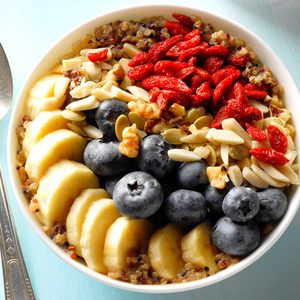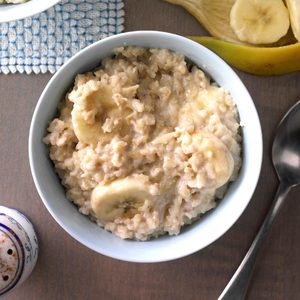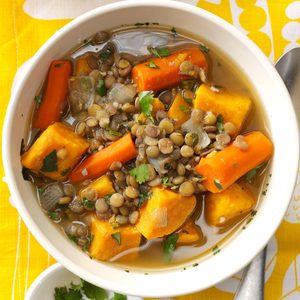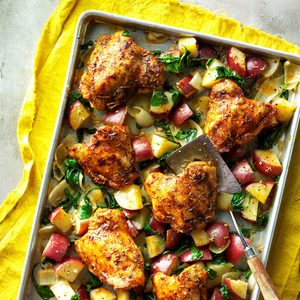What Is a Heart-Healthy Diet?

What's a heart-healthy diet? It's not just about the foods you eat, although they play a big part. We've got meal ideas, recipes and lifestyle tips straight from an expert.
If you’re looking for ways to improve your cholesterol and blood pressure readings, eating a heart-healthy diet is key. It has also been linked with a lower risk of obesity, type 2 diabetes and metabolic syndrome.
Here are four big tips to keep in mind when you’re defining what a heart-healthy diet means in your life.
Eat Heart-Healthy Foods
A heart-healthy diet is based on a few simple food groups that are quick and simple to prepare. And the flavor possibilities are endless!
- Vegetables: Aim to fill half your plate with fresh or cooked vegetables, such as a crisp salad or our Parmesan Roasted Broccoli.
- Fruits: Satisfy your sweet tooth with a variety of fruits. Reach for apple slices and nut butter for a quick snack or grilled peaches and blueberries for a bursting-with-flavor dessert.
- Whole grains: Give your body lasting energy with whole grains like oatmeal, whole-grain bread and brown rice.
- Lean protein: Build meals with protein sources, such as legumes, nuts, fish, seafood, poultry and low-fat or nonfat dairy.
- Liquid fats: When cooking, use nontropical, vegetable-based liquid fats, such as olive oil, canola oil, corn oil or sunflower oil. Avoid fats that are solid at room temperature, such as butter or margarine.
- Water: Keep a water bottle with you throughout the day to stay hydrated and help you avoid sugary beverages like soda.
Heart-Healthy Breakfast Ideas

Your heart-healthy diet starts at breakfast, and you may be surprised at how much variety you have to choose from. A bowl of whole-grain oatmeal is great for your health, but don’t be afraid to branch out. Just be sure to limit processed breakfast meats, such as bacon and sausage.
Heart-Healthy Lunch Ideas
Forget the office fast-food runs and upgrade your lunch situation with fresh salads, hearty soups and crunchy wraps. These heart-healthy lunches are quick to prepare and loaded with flavor.
Heart-Healthy Dinner Ideas
Heart-healthy dinners may not sound all that exciting, but the options are truly endless. To start building your meal, decide which vegetables to include. From there, add your favorite lean protein and whole grains.
Watching your cholesterol? Start with these low-cholesterol dinners.
Heart-Healthy Snack Ideas

One of the best tips for having plenty of heart-healthy snacks around is to plan ahead. Rather than waiting until you are hungry to make a choice, try prepping snacks in advance. Think crunchy veggies with a flavorful dip, fresh-fruit smoothies or whole-grain toast with nut butter.
Avoid These Foods
One of the best outcomes of adding more heart-healthy foods into your diet is that they tend to crowd out the not-so-healthy choices. It’s important to avoid or limit the foods that have been linked to an increased risk of heart disease: processed foods, fatty meats, sugary drinks and sweets. It’s also best to avoid foods that contain partially hydrogenated oils and tropical oils.
Consider Portion Size
In addition to eating heart-healthy foods, it is just as important to consume them in moderate portions. It is possible to overeat any type of food, even fruits and vegetables. While this is usually not the case, it’s important to remember how impactful portion sizes can be on our heart health.
The American Heart Association recommends the following daily portions:
- Vegetables: 5 servings or 2.5 cups
- Fruits: 4 servings or 2 cups
- Whole grains: 3 to 6 servings or 3 to 6 ounces
- Dairy products: 3 servings or 3 cups
- Protein sources: 1 to 2 servings or 5.5 ounces
- Healthy oils: 3 servings or 3 tablespoons
Live a Healthier Lifestyle
In addition to a healthy diet, you can improve your heart health and help prevent chronic disease through:
- Physical activity: Aim for 150 minutes of moderate physical activity or 75 minutes of vigorous physical activity per week.
- Not smoking and vaping: Avoid all tobacco and nicotine products.
Next Up: No hands-on time? Try one of these heart-healthy slow-cooker dinners for all the benefits without having to spend hours in the kitchen.



















